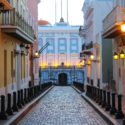What do terms “autonomy” and “commonwealth” mean in Puerto Rico?
A colony by any other name is still a colony
The term “autonomy” refers to flexibility in Puerto Rico’s home rule powers and relations with the U.S. federal government. Of course, this so-called “autonomy” exists only as allowed by Congress.
The current federally instituted and controlled regime of “autonomous” territorial home rule and administration of Puerto Rico’s local civil government, under a local constitution adopted by Congress in 1952, is called “commonwealth.”
Both “autonomy” and “commonwealth” are just political and ideological brand names given to the territorial government. The “commonwealth” regime of territorial government exercises local powers of sovereign self-government only as delegated by and with permission of Congress.
The Supreme Court has ruled that local powers of the “commonwealth” regime of territorial self government under the local constitution have no source other than the U.S. Congress.
The federal courts also have ruled that Congress can revoke delegated powers, and suspend or even amend the local constitution and local law to the extent incompatible with federal supremacy and U.S. law applicable to Puerto Rico.
In Puerto Rico there is a local political party that opposes statehood or independent nationhood for Puerto Rico. Instead, the “autonomist” party supports “commonwealth” as if it is a defined political status, when it is not.
Origins of “autonomy” doctrine
The autonomists borrow their name from a false promise of “autonomy” that Spain made to Puerto Rico to rally support for Spanish rule by the national government in Madrid as the U.S. challenged Spain’s crumbling empire in the Americas.
The so-called “Charter of Autonomy” that Spain adopted was a gimmick to appease Puerto Rican pro-democracy reformers after 400 years of tyranny, brutality, genocide and slavery under inhumane Spanish colonial rule.
Except for the Puerto Ricans who were Spanish collaborators rewarded with wealth and power for supporting Madrid, the Charter of Autonomy scenario was too little too late to turn back the tide of anti-Spanish sentiment.
There was already an independence movement and even a U.S. statehood movement among the large anti-Madrid factions in Puerto Rico. Most welcomed the U.S. invasion and end of Spanish rule.
It also is worth noting that after defeating the independence insurrection in the Philippines at a cost of over 100,000 lives, in 1916 the U.S. declared a national policy leading to independence for the territory. Subsequently, the U.S. adopted the Tydings-McDuffie Act, which established the “ commonwealth” of the Philippines with “ autonomy” deemed necessary for the transition to independence.
Thus, in Spanish law autonomy was a trick played on Puerto Rico and a form of fake sovereignty to create a diversion from authentic national sovereignty movements in the province ruled from Barcelona and its colonial regime in San Juan.
Under the territorial laws of the U.S. “ commonwealth” and “autonomy” were policies implemented to manage transition from territorial status to permanent independent nationhood. Thus, the Philippine model of territorial “commonwealth” and “autonomy” was a real world program for sovereign nationhood, not continued colonial status pretending to be a form of nationhood.
U.S. failed to define status options for Puerto Rico
When neither statehood nor independence was offered by operation of U.S. territorial law and policy, that created a political vacuum and there ensued a struggle between the statehood and separate nationhood movements.
The U.S. Congress, President and federal courts were non-committal and federal law and policy was ambiguous. Citizenship was conferred without any promise of statehood, and independence was recognized as possible as well.
That’s when “autonomy” and “commonwealth” became the label for remaining a U.S. territory with U.S. citizenship and federal subsidization of the local economy, while claiming to be a separate “autonomous” nation at the same time.
“Autonomists” fill the vacuum
Before and after the local constitution was adopted in 1952, the “autonomist” party platform garnered enough support to prevent statehood, independence or the autonomists’ own “commonwealth” platform from winning decisive majority support in a series of local status votes.
Not until 2012 did statehood win a decisive majority over the “commonwealth” regime, despite contrived arguments contesting even that certified result. Independence never garnered more than 5% in local votes.
Yes or no vote on statehood now necessary
The last hurdle to restoring Puerto Rico on the path of democratic self-determination it was diverted from by the autonomy myth, is for the federal and local governments to keep their agreed upon rendezvous with destiny.
At the federal and local level a formal commitment exists under law for a federally sponsored status vote in which a yes or no ballot question on statehood is an option recognized and authorized by Congress.
When that happens, terms like “autonomy,” “commonwealth” and “unincorporated” will not matter anymore. What will matter is if the majority of voters in a U.S. citizen populated territory vote to join 32 other U.S. citizen populated territories that have been admitted to the union.
On what basis could Congress deny to Puerto Rico what it has granted to 32 other territories, most if not all less ready for statehood that Puerto Rico?








No responses yet